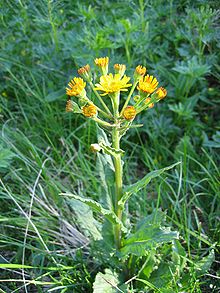| Tephroseris palustris | |
|---|---|

| |
| Scientific classification | |
| Kingdom: | Plantae |
| Clade: | Tracheophytes |
| Clade: | Angiosperms |
| Clade: | Eudicots |
| Clade: | Asterids |
| Order: | Asterales |
| Family: | Asteraceae |
| Genus: | Tephroseris |
| Species: | T. palustris
|
| Binomial name | |
| Tephroseris palustris (L.) Schrenk ex Rchb.
| |

| |
| Range of T. palustris | |
| Synonyms | |
|
List
| |
Tephroseris palustris, also known by its common names swamp ragwort, northern swamp groundsel, marsh fleabane, marsh fleawort, clustered marsh ragwort and mastodon flower, a herbaceous species of the family Asteraceae. It can be seen most easily when its bright yellow umbel flowers appear from May to early July standing 3 to 4 feet (0.9 to 1.2 m) along marshes, stream banks and slough areas where it likes to grow.[1][2][3]
- ^ Kershaw, Linda (2003). Saskatchewan Wayside Wildflowers. Edmonton, Alberta: Lone Pine Publishing. p. 84. ISBN 1-55105-354-3.
- ^ Wilkinson, Kathleen (1999). Wildflowers of Alberta A Guide to Common Wildflowers and Other Herbaceous Plants. Edmonton Alberta: Lone Pine Publishing and University of Alberta. p. 284. ISBN 0-88864-298-9.
- ^ NDSU Extension Service. "Swamp ragwort". ND Noxious & Troublesome Weeds. North Dakota State University USDA Cooperative extension service. Retrieved 2008-02-23.
Swamp ragwort has been increasing in frequency recently and infestations should be monitored even though the plant generally is not considered invasive.